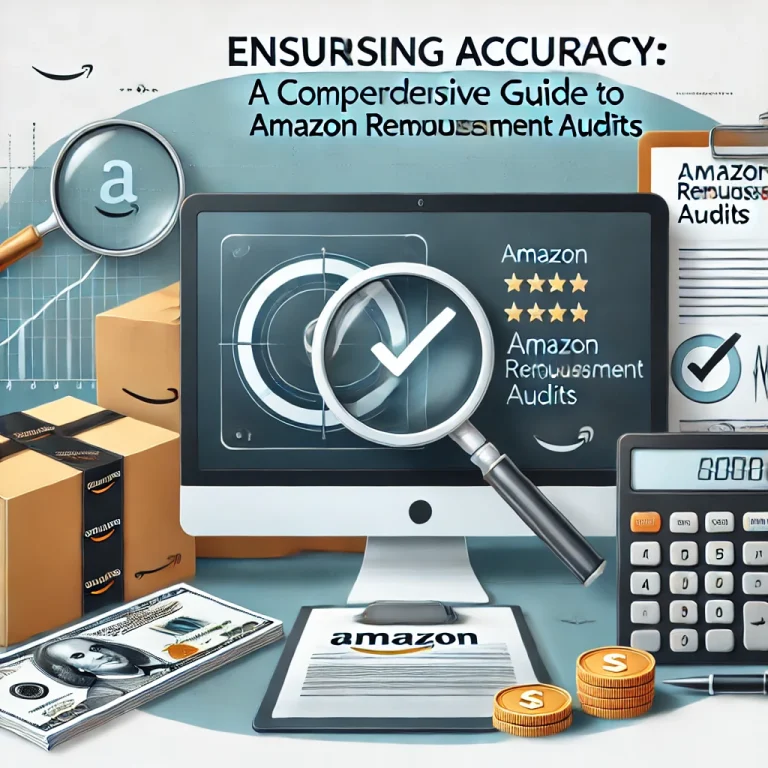As an Amazon seller, maintaining a healthy bottom line requires diligent oversight of your financial transactions and inventory. One essential tool in your financial management arsenal is the Amazon reimbursement audit. This audit process ensures that you recover money owed to you due to various discrepancies such as lost inventory, damaged goods, and overcharged fees. This article will guide you through the process of conducting an Amazon reimbursement audit, its benefits, and the best practices to ensure you maximize your reimbursements.
What is an Amazon Reimbursement Audit?
An Amazon reimbursement audit involves systematically reviewing your Amazon seller account to identify discrepancies where Amazon owes you money. These discrepancies can arise from:
- Lost Inventory: Items that go missing in Amazon’s fulfillment centers.
- Damaged Goods: Products damaged while in Amazon’s custody.
- Customer Returns: Items returned by customers but not properly restocked or refunded.
- Overcharged Fees: Incorrect fees charged by Amazon for various services.
- Lost Shipments: Items lost during transit to or from Amazon warehouses.
By conducting regular audits, sellers can ensure that they recover all funds owed to them, thereby improving their overall profitability.
Why Conduct an Amazon Reimbursement Audit?
- Recover Lost Funds: Identify and claim reimbursements for discrepancies to recover lost revenue.
- Improve Accuracy: Ensure that your financial records accurately reflect your business transactions.
- Enhance Profitability: Maximize your profits by ensuring all owed funds are recovered.
- Compliance: Maintain compliance with Amazon’s policies and guidelines for reimbursements.
Steps to Conduct an Amazon Reimbursement Audit
1. Gather Necessary Data
Start by collecting all relevant data from your Amazon Seller Central account. This includes transaction records, inventory reports, and fee statements. Ensure you have access to:
- Inventory Reports: Track the movement of your inventory in and out of Amazon’s fulfillment centers.
- Fee Statements: Review all fees charged by Amazon to ensure they are accurate.
- Return Reports: Monitor customer returns to ensure they are processed correctly.
2. Identify Discrepancies
Analyze the collected data to identify discrepancies. Look for patterns or anomalies that indicate potential issues, such as:
- Lost or Missing Inventory: Compare your inventory records with Amazon’s reports to identify any missing items.
- Damaged Goods: Check for products listed as damaged in Amazon’s fulfillment centers.
- Customer Returns: Ensure that returned items are properly restocked or refunded.
- Incorrect Fees: Review fee statements to identify any overcharges or incorrect fees.
3. Generate and Submit Claims
Once discrepancies are identified, generate claims for reimbursement. Ensure that your claims are detailed and comply with Amazon’s reimbursement policies. Include:
- Detailed Description: Clearly describe the discrepancy and the amount claimed.
- Supporting Documentation: Provide necessary documentation, such as transaction records and inventory reports, to support your claim.
- Compliance: Ensure that your claim adheres to Amazon’s guidelines for reimbursements.
Submit your claims through Amazon Seller Central and monitor their status to ensure they are processed promptly.
4. Follow Up on Claims
Monitor the status of your submitted claims and follow up if necessary. Ensure that all claims are resolved and that you receive the reimbursements owed to you. Keep detailed records of all communications and resolutions.
Tools for Conducting Amazon Reimbursement Audits
Several tools can help automate and streamline the reimbursement audit process:
- Refunds Manager: Offers comprehensive audit services, handling everything from data analysis to claim submission.
- AMZRefund: Known for its user-friendly interface, AMZRefund helps sellers recover lost revenue with minimal effort.
- Getida: Provides robust audit services with a focus on maximizing recovery. Offers a free audit to estimate potential reimbursements.
- Seller Investigators: Specializes in identifying discrepancies and filing claims. Offers a transparent pricing model with no hidden fees.
- Helium 10 Refund Genie: Part of the Helium 10 suite, Refund Genie simplifies the reimbursement process for sellers.
- SellerLocker: Combines reimbursement claims with inventory management tools, providing a comprehensive solution for Amazon sellers.
Best Practices for Amazon Reimbursement Audits
- Conduct Regular Audits: Schedule regular audits to ensure ongoing accuracy and recovery of funds.
- Stay Informed: Keep up-to-date with Amazon’s reimbursement policies and guidelines.
- Use Automation Tools: Leverage automation tools to streamline the audit process and reduce manual effort.
- Maintain Detailed Records: Keep detailed records of all transactions, claims, and communications to support your reimbursement efforts.
- Follow Up Diligently: Monitor the status of your claims and follow up to ensure timely resolution and payment.
Final Thoughts
Conducting regular Amazon reimbursement audit is essential for maintaining financial health and maximizing profitability as an Amazon seller. By systematically identifying and claiming discrepancies, you can recover funds owed to you and ensure the accuracy of your financial records. Utilize the available tools and follow best practices to make the most of your reimbursement audits and safeguard your business’s profitability.
Stay proactive and diligent in your auditing efforts, and enjoy the peace of mind that comes with knowing your revenue is accurately accounted for. Happy selling!




